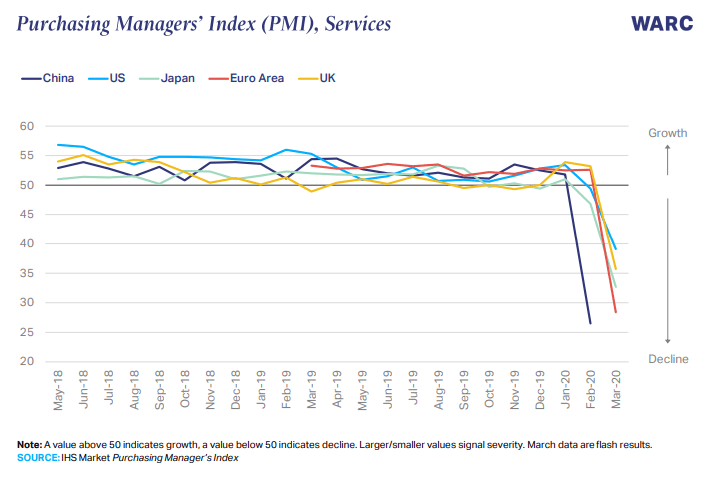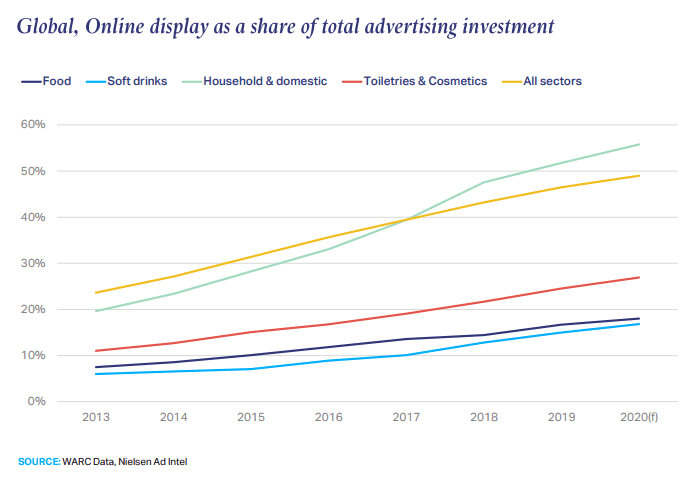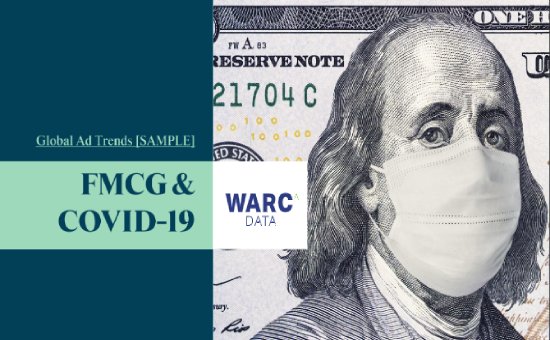Global Ad Trends: FMCG & COVID-19, March, 2020 | WARC
Digital Advertising | Global
The world is facing a crisis nowadays due to the swift spread of COVID-19. It is obvious that there are a lot of industries and economies have been affected by COVID-19. There have been a lot of changes in our lives, students started remote learning as well as workers who started to work from home. Consumers also are now adjusting to living the new normal and get used to this crisis-buying habits.
In light of that, WARC has released a new sample report investigates the impact of COVID-19 on the FMCG industry.
Let’s take a quick look at the top-line findings…
The Impact of COVID-19 on Economies
As mentioned earlier COVID-19 has an impact on major economies and most of them are likely to fall into recession. And this is likely to lead to an advertising recession.
The chart below shows the great decline in the purchasing managers’ index (PMI), services in China, the US, Japan, the Euro Area, and the UK.

A Figure Shows the Purchasing Managers’ Index 2020
In light of that, central banks have already announced a swathe of motives in order to keep economies afloat, however, the COVID-19 pandemic is not anything close to a normal recession – PMI data show a far more precipitous fall in services activity than would usually be expected.
Related Report: Coronavirus Ad Adjacency: A Consumer Study 2020
FMCG Ad Money Is Shifting Online
When it comes to FMCG, we can say that major FMCG advertisers reduced ad investment in 2008/2009, but is held as a share of sales revenue. However, FMCG sales on Tmall and Amazon have flourished.
On the other side, FMCG ad money is moving online, however, for brand building, it is still important while selling through third-party retailers and not straight to customers. Talking about brand building, it is highly important for food and soft drinks, as online spending is growing in line along with the wider market, TV spend is still 4.5 and 3.8 times higher, sequentially.
The chart below shows the global online display ads as a share of total advertising investment.

A Figure Shows the Global Online Display Ads as a Share of Total Advertising Investment (2013-2020)
It is obvious that the disruption of activity caused by COVID-19 creates the opportunity for brands to build lasting relationships, however, communications need to be positive and dynamic.
Related Report: COVID-19: How Businesses are Handling the Crisis Report
Advertising Spend as a Share of Sales Revenue
The chart below shows the advertising spend as a shared revenue over the years from 2007 to 2010 for Unilever, P&G, Nestlé, Coca-Cola, L’Oréal.

consumers are stacking food and drink which might lead to a short-term increase in sales income. Sales revenue was falling among five of the biggest FMCG companies in 2009, though only Coca-Cola and P&G cut ad investment.
However, previous recessions show longer periods off-air will decrease brand health and damage market share because of a reduction in the share of voice.
What’s in the “Global Ad Trends “FMCG & COVID-19″ Report”:

Global Ad Trends 2020: The Impact of Covid-19 on FMCG Industry
- Key takeaways
- FMCG & COVID-19
- Adspend during the last recession
- Media owner profiles
- Latest market intel
- Contact us
Number of Pages:
- 18 pages
Pricing:
- Free






